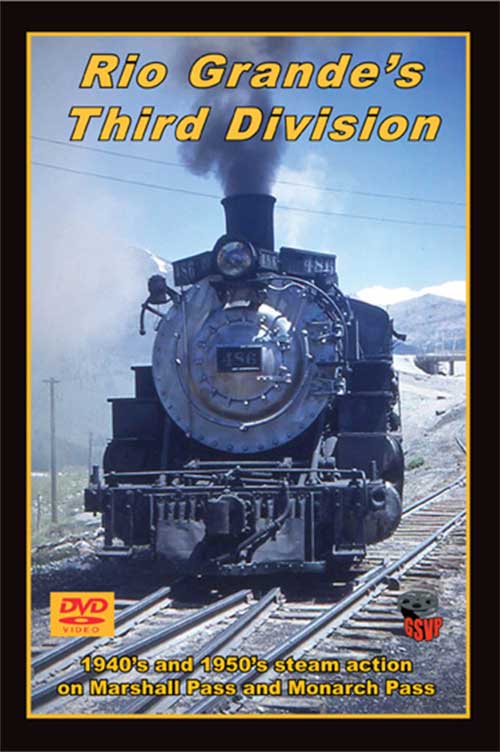Rio Grandes Third Division DVD
DT (Colorado - Home of the Narrow Gauge) on 2016-01-17 17:49:28.
People who found this review helpful: 3
Great scenery. Rare footage of Gunnison, Sargents, Marshall Pass, Mears Junction and Salida and its facilities.
The fantastic footage is totally ruined by an AWFUL AND INCESSANT MUSIC TRACK in place of dubbed train sounds (Somewhat amateurish narration also is a detraction)
In an era of digital sound and electronic editing it is almost criminal to produce a DVD without the appropriate "sounds of steam". (The classes of locomotive shown in this DVD still operate daily on the Durango and Silverton and Cumbres and Toltec railroads if new sound recordings were needed)
The noxious music make this potentially excellent video a complete disappointment
Additional remarks by DT:
Narration: Just enough.
Would kids enjoy this? I doubt it.
Image quality: Good.
DVD Value: Overpriced for the amount of enjoyment I got out of it.
Recommend to others? Definitely not!.
Rio Grandes Third Division DVD
Steamboy (Revere MA US) on 2020-12-12 18:24:35.
In this recently turned 5 year old program from 2015, it starts with a brief history of the abandoned third division that was formed in September of 1880 which includes a map of the Monarch pass route, & the state of colorado itself. Remember that the Green Lines are for Narrow gauge only, while the black line is for standard gauge, & the line from Alamosa to Antonito is the Dual gauge line.
The first scene is the only Black & white footage from 1939 showing 479 at Gunnison while backing into a freight house. Note the Scratches on the pilot plow. The final westbound run was on November 20, 1940. Afterwards we see 1882 built consolidation number 268 at the 1949 Chicago railroad fair.
Now we moved to the main event: a 3 engine freight train that was filmed by Billie Bowen on August 6, 1947. First we see a panning shot of engines 491, 492, 495, & 496 at Gunnison. 491 is on display at the Colorado Railroad Museum in Golden. Next we witnessed the 11 stall roundhouse at Gunnnison while 491 & 492 are being serviced. Meanwhile 495 & 496 are taking turns to have their tenders filled with water, & later being switched to the next track as well as a short ride on the rear of the caboose. At Doyle Colorado, 496 picks up some more cars on the siding, then we witnessed a head-on shot of 492 that is following right behind us. After 495 recouples to 496, the freight is underway once again. At the same time, 492 pulls the caboose with our cameraman onboard tender first at Sargent Colorado, so that it could be on the rear of the locomotive for pusher service to help 495 & 496. Marshall pass is 17 miles east of Sargent. At milepost 244.8, the freight is passing by Shawano where the water tower is being stored there. Our final scene with the 490 series mikes are at the .5 mile from the summit of the pass.
On August 12, 1947, 499 is operating an excursion over Marshall pass. This trip was sponsored by the National Model Railroader's Association. The coverage begins at milepost 229 as one of the passengers wave for the chasers at Shirley. Note the passengers on top of the caboose. 499 not only arrives at the Summit of the pass, but also entering the snowshed there. The snowshed is located at milepost 240.7. A still image of the interior of the snowshed is shown, & we see the view of the Rockies from Marshall pass. Everyone enjoyed the scenery, but its time to go back as 499 passes by the Summit's own water tower. Moments later, 499 heads for Mears Junction as it goes under the bridge where the track above it goes to Alamosa, & its at an elevation of 8,431 feet near milepost 226. The Arkansas Valley is in the distance as 499 approaches Salida. The final freight run on Marshall pass was on May 2, 1955 with 489 & 483 in charge. You can see the official farewell to Marshall pass freight in Rio Grande of the Rockies by WB Video Productions in 1985, that was filmed by Irving E. August.
Now we moved to the Salida to Monarch branch which includes a map of the route that contains the Junctions at Mears, Poncha, & Salida, Plus the Maysville Loop, as well as the Garfield Switchbacks. First we see a single engine train beginning with 493 on the Dual gauge tracks in November of 1946 as one of the many since been scrapped standard gauge steamers: 2-8-0 number 1161 appears on the far right of the screen. Not only is 493 restored to service on the Durango & Silverton, but its also converted to oil to prevent huge brushfires just like what happened in 2018. Afterwards we see 480 & 481 at Salida Yard, followed by 481 passing by Poncha junction station as it heads for Monarch, then it rolls east of Maysville, takes the first half of the train to the switchback, & later see the second half of the train at the loop while crossing highway 50, then later backs into the switchback, cross highway 50 again & silver creek at monarch, & see some switching action at the Limestone Quarry. Like 493, these 2 K-36 type locomotives are also operating on the D&S. Another Black & white reel is shown as 482 is over the Maysville loop. This reel was filmed by Everett Roeher in the Early '50s. 482 is also operating on the D&S. Some Quick pacing is included as well as 482 passing by the wye in monarch where it'll do some back & forth movements.
Concluding the Single engine trains, we now focused on the Double engine movements. Most of these scenes were shot by Jack Alexander with a few by Ken Johnson who were on the same trip with Russ Ahrnke & Cliff Grant. First we see 486 at the Lower Switchback with the Second half of the train on June 26, 1951. Like the other preserved engines in this program, 486 is also on the D&S. 481 is the lead locomotive as it'll soon assemble both sections. While 486 ran light to Maysville, 481 continues to put the sections together. 486 arrives at the highway 50 crossing at the Maysville loop while 481 would follow behind with the loaded cars of limestone. At Maysville, the caboose is dropped off for a flying switch as the second half of empty gondolas are being switched for Monarch. 481 handles the freight while 486 is pushing on the rear with the caboose behind the tender. Approaching the Garfield Switchback, 481 & 486 are entering the loop & highway 50 crossing with 2 angles by Mr. Alexander & Mr. Johnson. The 2 locomotives are over the Maysville Crossing with 2 angles by Ken & Jack Once again. Next we witnessed the action at the Garfield Switchback with Both Angles from the same 2 cameramen once again. First we see 481 at the Lower stub & siding of the switchback, followed by 486 pushing the second half of the train on the lower portion of the switchback Which includes the brakeman throwing the switch so that 486 can follow 481 as well. The Middle section of the switchback has a giant rock acting as a dead end buffer as evidenced by a still image. Next we see 481 & 486 at the highway 50 crossing once again as it approaches Monarch. In the Mine, the 2 engines are being turned on the wye as 486 does an example of one of them, then we see some of the gondolas being loaded with Limestone as the train gets assembled. 486 runs light once again as 481 would handle the hard work itself. With the cars loaded up, 481 heads for the switchback as it heads back to Salida. Here the locomotive can only take 14 cars at a time. At the bottom of the lower switchback, 481 reassembles the train, & heads for the Mayville loop while crossing highway 50, & entering the siding, before we see a quick pace of 486.
On another trip, an Unidentified filmmaker was recording more 2 train action as 480 & 481 handle the freight to Monarch. 480 is the lead locomotive while 481 is on the rear. Our first scene shows the 2 engines at the Highway 50 Crossing in Maysville. A maintenance Speeder is following behind the steam engines. Next we see 481 pushing on the rear while on top of the loop, followed by a brief look at the blackberry bush which is near the roadbed, then we see 480 bellow Garfield as the 2 engines approach the Switchback. 480 takes the first 14 cars backwards while 481 follows behind. 480 crosses over silver creek bridge, & we see some more action at the Monarch Mine where the cars are loaded once again. Next we see the 2 engines turning on the wye before heading for the switchback once again as well as Salida. This scene concludes the Monarch Branch.
Back in Salida, there is some rotary Barrel transfer action there as the Narrow gauge were Transferred to the Standard Gauge. Note the Counterweights going up at the Narrow gauge cars are unloading the Limestone to the Standard gauge cars for Pueblo. Before these were built in 1924, it used to take more than 75 men to remove the Limestone on one car in a day. Throughout this segment, look carefully for car 1381 which was Badly Damaged. The Rotary Dumpers were removed on Cumbres pass in 1957 or 1958. 5 men are used to run the transfer unit. 1 for the machine, the other 4 for each of the cars.
The final segment in this program shows 489 on a work train during July 30, 1956. This is the day in history where the Marshall Pass Line would be transformed to Standard Gauge. First we see 489 at Poncha Junction, followed by a still image of 482 on a standard gauge flat car to Alamosa, & see 489 at work as the Track itself begins the Widening process. Today 489 is at the Cumbres & Toltec Scenic on the Chama to Antonito Line. West of Maysville, a Different work train is shown as it goes on the temporary track. At the Loop, the New Ties & rails are being unloaded. The conversion took only a month & all trains have since been taken over by diesels until the Standard gauge line to Monarch pass ended in 1981, & have since been removed in 1983-1985.
In the Closing Credits, look carefully for One of the Since been Scrapped Standard Gauge Steam Giants on the Rio Grande: Articulated 2-8-8-2 number 3614. A young Perry Becker filmed 268 in 1949.
Additional remarks by Steamboy:
Narration: Just enough.
Would kids enjoy this? Yes.
Image quality: Good.
DVD Value:: Fair.
Recommend to others? Definitely.

 Earn points for free DVDs. Signup free.
Earn points for free DVDs. Signup free. Login/Register
Login/Register Help
Help 3.5 of 5 (
3.5 of 5 (
 if ordered now. (PST)
if ordered now. (PST)
